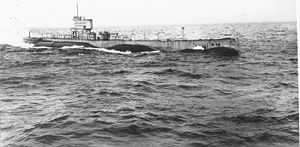USS S-49 (SS-160)
 | |
| Career | |
|---|---|
| Name: | USS S-49 |
| Builder: | Lake Torpedo Boat Company |
| Laid down: | 22 October 1920 |
| Launched: | 23 April 1921 |
| Commissioned: | 6 June 1922 |
| Decommissioned: | 2 August 1927 |
| Struck: | 21 March 1931 |
| Fate: | Sold on 25 May 1931, used as tourist attraction, then used as experimental equipment. Accidentally sunk in 1942. |
| General characteristics | |
| Class and type: | S-class submarine |
| Displacement: | 993 long tons (1,009 t) surfaced 1,230 long tons (1,250 t) submerged |
| Length: | 240 ft (73 m) |
| Beam: | 21 ft 10 in (6.65 m) |
| Draft: | 13 ft 6 in (4.11 m) |
| Speed: | 14.6 knots (16.8 mph; 27.0 km/h) surfaced 11 knots (13 mph; 20 km/h) submerged |
| Complement: | 38 officers and men |
| Armament: | • 1 × 4 in (102 mm) deck gun • 5 × 21 in (533 mm) torpedo tubes |
USS S-49 (SS-160) was a fourth-group (S-48) S-class submarine submarine of the United States Navy. Her keel was laid down on 22 October 1920 by the Lake Torpedo Boat Company in Bridgeport, Connecticut. She was launched on 23 April 1921 sponsored by Mrs. Joseph E. Austin, and commissioned on 6 June 1922 with Lieutenant Ingram C. Sowell in command.
Service history
Commissioned at Bridgeport, S-49 remained there through July, and, in August, moved down to the Submarine Base at New London, Connecticut, where she joined Submarine Division Zero, composed of units engaged in submarine research and development. Later reassigned to Division 4 and then to Division 2, she continued experimental work, including aerial visibility tests and torpedo development, and also participated in regularly scheduled exercises, primarily in the New London area, into 1926. At the end of January of that year, she proceeded to Portsmouth, New Hampshire, for a regular overhaul. On 2 April, she returned to New London; but, eighteen days later, her operating schedule was again interrupted.
At about 07:50 on Tuesday, 20 April, S-49’s engines were started. Seven minutes later, just as a pilot cell cover was removed to test the specific gravity of the electrolyte, the forward battery exploded. The hydrogen gas explosion destroyed the cells in the forward half of the battery and forced up the battery deck. Ten men were injured. Two others were gassed during rescue operations. Four of the twelve died of their injuries.
The battery compartment was sealed and kept shut until mid-afternoon when the outboard battery vent was opened. During the night, the submarine took on a slight list to port and air pressure was used to keep ballast. At about 05:15 on 21 April, a second explosion occurred in the battery room when wash from vessels departing for torpedo practice rocked S-49. The compartment was resealed for another few hours, after which the work of clearing the wreckage was begun.
Following repairs, S-49 resumed operations off the New England coast, and in January 1927, moved south, with USS S-50, for exercises and tests off Key West, Florida, the Dry Tortugas, and in Tampa Bay. On 12 March, she returned to New London, whence she completed a run to Portsmouth and back before proceeding to Philadelphia, Pennsylvania, with S-50, for inactivation. Arriving on 31 March, she was decommissioned on 2 August and berthed with other reserve ships at League Island until struck from the Naval Vessel Register on 21 March 1931 in accordance with the London Naval Treaty. S-49 was sold to the Boston Iron and Metal Company of Baltimore, Maryland, on 25 May 1931.
Tourist attraction
In 1931 S-49 was purchased by "Captain" F. J. Chrestensen and toured the east coast for several years as a floating exhibit and tourist attraction, for which he charged a 25 cent admission. In 1936 she was an exhibit at the Great Lakes Exposition in Cleveland, Ohio.
In 1942 Chrestensen was the respondent in the Supreme Court case Valentine v. Chrestensen in which he was accused of violating, in 1940, a New York City ordnance against distributing handbills for commercial purposes for distributing flyers advertising the S-49. The court ruled that distribution of handbills could only be for informational or protest purposes. Chrestensen reissued a handbill which deleted the admission charge and had a protest on the back against the City Dock Department for refusing the grant him dockage.
Chrestensen also published a booklet describing the S-49 and promoting the capabilities of submarines.
S-49 is likely to be the only submarine to have been a privately owned traveling tourist attraction.
Disposal
The S-49 was apparently reacquired by the Navy about 1941, "as equipment," for use in experimental work at the Naval Mine Warfare Proving Ground, Solomons, Maryland. Shortly after being towed to Solomons from Baltimore (where the Navy had reacquired the submarine), the former S-49 foundered off Point Patience in the Patuxent River on 16 December 1942 and sank in 102 feet of water at: Position: Latitude 38 Degrees 19' 53.2" North Longitude 76 Degrees 29' 17.2" West or, on a bearing of 318.5 Degrees True, distant 525 yards, from the southern tip of Point Patience. The S-boat has remained on the bottom at that position to the present day...and is visited, on occasion, by Navy and recreational divers. Courtesy of R. S. Rayfield, Jr. Major, USMC (Ret)
References
- This article incorporates text from the public domain Dictionary of American Naval Fighting Ships.
- Navsource.org - Features several photos of the S-49.
| ||||||||||||||||||||||||||||||||||||||||||